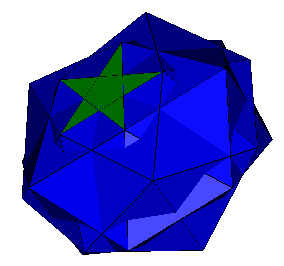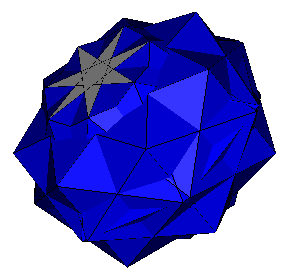

Bi-Snub Anti-Prisms
 |
 |
This is a similar infinite family to the Snub Anti-Prisms, this time of 3-uniform polyhedra. The base n/d-gon is this time surrounded by vertices of the form n/d.3.3.3.3.3 (vertex type "A"), the snub vertices are again of the form 3.3.3.3.3 but this time they fall into two distinct categories, those which are directly connected to the 'base' vertices (type "B") and those which appear on the 'equator' of the solid (type "C"). If this is not obvious from the images above take a look at this cutaway model of a 7/3 great snub anti-prism where only one rotation of the triangular faces around the prismatic axis of symmetry is shown.
They are generated from the anti-prism by the insertion of a band of triangles between each of the base n/d-gons and the prismatic triangular faces. These prismatic triangular faces are separated into pairs. The insertion of these two bands of triangles is the source of my name of "Bi-Snub Anti-Prisms". See this example of a highlighted 5/2 bi-snub anti-prism with the snub triangles in yellow.
The family is convex for 2 <=n/d < 3, n/d=3 is the limiting case with a number of co-planar faces. n/d > 3 gives a non-convex polyhedron (see n/d=4 or n/d=5 ) The icosahedron again falls into this family if n/d=2, this is the only n-gonal convex member of this family.
Bi-snub anti-prisms also exist for n/d<2. In these cases the base polygon is retrograde, for example this 5/3 bi-snub-anti prism, 7/4 bi-snub-anti prism and 11/6 bi-snub-anti prism
A full table of locally convex
great
snub anti-prisms with d>1 and n<=12 is below.
| Bi-snub Anti-prisms: | 5/2 | 7/3 | 8/3 | 9/4 | 11/4 | 11/5 | 12/5 |
Great Bi-Snub Anti-Prisms
In similar fashion to the snub anti-prisms, a family of polyhedra also exists which is isomorphous to the bi-snub anti-prisms. This family also has starred vertices. An example of this family, which I term "great bi-snub anti-prisms", is the 7/3 great bi-snub anti-prism shown above left. Again, the great icosahedron is a member of this family as the "digonal great bi-snub anti-prism" in the same way that the icosahedron is the "digonal bi-snub anti-prism". Models can also be generated with n/d<2, in this case the base polygon becomes retrograde which has the effect of partially un-crossing the type "A" vertices. For example, the 7/4 great bi-snub anti-prism (above right) and this 5/3 great bi-snub anti-prism.Examples of the family
generated to date are below:
| Great bi-snub anti-prisms: | 5/2 | 7/3 | 8/3 | 9/4 | 11/4 | 11/5 | 12/5 |
Unlike the snub
anti-prisms, the bi-snub anti-prisms do not appear to have any
exotic
isomorphs.
See also: N-gonal Substituted Polyhedra